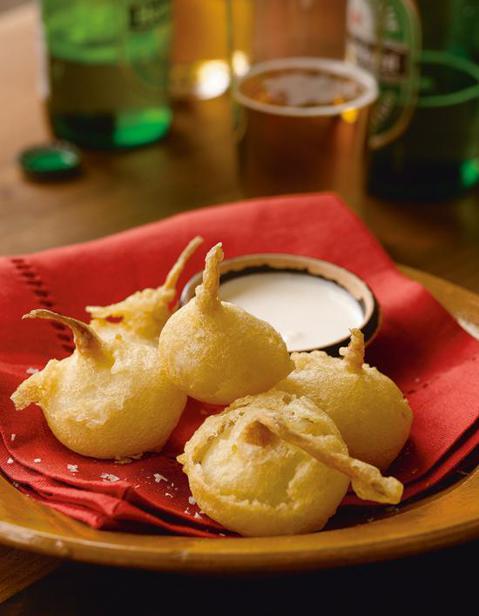Cook Like a Rock Star (10 page)
Read Cook Like a Rock Star Online
Authors: Anne Burrell

5
When the polenta is set, cut it into 1-inch squares. Put the squares on a baking sheet and top each with a piece of Taleggio.
6
Put the cherry tomatoes on a separate baking sheet and toss them with olive oil. Bake both the polenta squares and the tomatoes for 10 minutes. The tomatoes should be hot, starting to relax, and getting a little squishy, and the Taleggio should be nicely melted.
7
Put the polenta cakes on a serving dish, top each square with a cherry tomato half, and garnish each with a little sprinkey-dink of coarse sea salt and chives.
What a corn cake!!!
Polenta starts to bubble like hot lava fields and if it gets on you it will stick and burn—so watch out!

SERVES: 6 TO 8 • TIME: ABOUT 45 MINUTES
Cauliflower is one of my favorite vegetables. I love to jack it up with some bread crumbs and Parm and deep-fry it till it’s nice and brown. These are little bites of crunchy, cheesy, salty, heavenly loveliness. Add some garlicky goodness in the form of a dipping sauce and you have a showstopper!
MISE EN PLACE
FOR THE CAULIFLOWER
Kosher salt
1 head of cauliflower, cut into bite-size florets
2 cups peanut or other neutral-flavored oil
1 cup all-purpose flour
2 large eggs, beaten with 2 tablespoons water
1 cup bread crumbs
1 cup freshly grated Parmigiano
FOR THE GARLIC DIPPER
2 cups day-old or stale rustic Italian bread, crusts removed and cubed
2 tablespoons red wine vinegar, or to taste
2 cloves garlic, smashed
½ cup extra virgin olive oil
Kosher salt
FOR THE CAULIFLOWER
1
Bring a large pot of well-salted water to a boil, set up a large bowl of well-salted ice water, and line a baking sheet with paper towels. Toss the cauliflower florets into the boiling water. When the water returns to a boil, cook the cauliflower for 2 more minutes, then drain and immediately plunge into the ice water. When the cauliflower has cooled, drain it and lay it out to dry on the prepared baking sheet. (While you wait, you can get your dipper going—now that’s what I call multitasking!)
2
Pour the peanut oil into a large saucepan over medium-high heat; the oil should come 1½ to 2 inches up the sides of the pan. To see if it’s hot enough, drop some flour into it. If the flour sizzles and floats quickly, you’re good to go. If the flour burns or the oil begins to smoke, it’s too hot, so reduce the heat.
3
While the oil heats, set up your
standard breading procedure
: one bowl of flour, one bowl with the egg-water mixture, and one with the bread crumbs and grated Parm.
Then set up your drying situation next to the stove by putting a couple layers of paper towels on a baking sheet. When the oil is hot, dredge the cauliflower in the flour and shake off the excess, then run it through the egg mixture, and finally through the bread crumb–Parm mixture. Repeat this process with all the cauliflower.
4
Working in batches so you don’t overcrowd the pan, fry the cauliflower until brown and crispy, 3 to 5 minutes; then transfer to the paper towels, sprinkle with salt, and serve hot, hot, hot with the garlic dipper.
FOR THE DIPPER
In a medium bowl, toss the bread with enough water to really moisten it up; you want it almost soggy. Then squeeze out the excess water and put the bread, vinegar, and garlic in a food processor and purée, purée, purée—it should be really smooth! While the machine is still running, drizzle in the olive oil until combined. Season with salt and more vinegar if you like—I like a very bright, acidic dipping sauce. Put the dipper in a dish and serve it along with the cauliflower.
Mmmmm … salty, crispy, crunchy cauliflower and garlicky gooooodness!
STANDARD BREADING PROCEDURE
(a.k.a. The Way to Coat Stuff for Deep-Frying)
The point of the standard breading procedure is to coat something—anything, really—in bread crumbs so when it’s fried, it comes out with a nice even, crispy coating. The key ingredients here are flour, egg wash, and bread crumbs, but there are two pieces of essential equipment that are often forgotten—the wet hand and the dry hand. In between these two essentials is the continental divide, and never the two shall cross.
Start by using your dry hand to coat whatever ingredient you plan to fry in flour and shake off the excess. Then, still using your dry hand, pick up the ingredient and drop it into the egg wash without letting your dry hand get wet. Then, using your wet hand, pick up your ingredient and drop it into the bread crumbs. Switch back to your dry hand to pack on the bread crumbs for a firm, even coating. By following this simple dry-wet-dry-hand approach, your ingredients will be properly breaded AND there will be no clumpage on the ends of your fingers. Ta-da!

SERVES: 6 TO 8 • TIME: ABOUT 30 MINUTES
Cipolline are flat, sweet Italian onions that look like little flying saucers. I love these guys because they’re like onion rings with no holes. Perfectly fried baby onions and garlic mayonnaise to dip them in—they’re out of this world!
MISE EN PLACE
FOR THE CIPOLLINE TEMPURA
Kosher salt
1 pound small cipolline onions
1 cup cake or rice flour
1 tablespoon baking powder
½ to ¾ cup ice-cold sparkling water
2 cups peanut or other neutral-flavored oil
FOR THE AÏOLI
2 egg yolks
3 tablespoons red wine vinegar
2 cloves garlic, smashed
Pinch of crushed red pepper, or to taste
Peanut or other neutral-flavored oil
Kosher salt
FOR THE TEMPURA
1
Bring a medium pot of well-salted water to a boil. Toss in the cipolline and cook for 5 to 7 minutes or until tender. Drain and let cool. (While these are cooling, I suggest you save time and whip up your aïoli. BTW, this is multitasking!)
2
When the onions are cool enough to handle, use a paring knife to peel off the outer skin and trim the hairy root end; reserve.
3
To make the tempura batter, combine the flour, baking powder, and ½ teaspoon salt in a large bowl. Add the cold (seriously—ice-cold!) sparkling water and mix until a loose batter forms; don’t worry about the lumps.
4
When you’re ready to cook, pour the peanut oil into a large saucepan over medium-high heat; the oil should come 1½ to 2 inches up the sides of the pan. To see if it’s hot enough, drop a couple of little batter balls into it. If they sizzle and float quickly, you’re good to go. If the batter burns or the oil begins to smoke, it’s too hot, so reduce the heat.
5
While the oil heats, set up your drying situation next to the stove by putting a couple layers of paper towels on a baking sheet. Dip and coat each of the onions in the tempura batter, then add them one at a time to the oil. Work in batches—you don’t want to overcrowd the pan—and fry them until the batter is crisp but still pale and golden. Remove the onions from the oil and salt these puppies immediately.
FOR THE AÏOLI
In the bowl of a food processor, combine the egg yolks, vinegar, garlic, and red pepper and process until combined. Then, with the machine running, begin to add the oil a drop at a time—you want to do this slowly in the beginning until the mixture begins to thicken and look homogeneous. Once this happens, add the remaining oil in a thin stream until it is all combined; taste and season with salt. Serve the garlicky mayonnaise with the crispy sweet onions.
Take THAT, onion rings!

SERVES: 6 TO 8 • TIME: ABOUT 2 HOURS, MOSTLY UNATTENDED
This is not your ordinary bean dip. A lovely combo of beans, veggies, rosemary, and prosciutto makes this a simple but sophisticated twist on an old standby—and, while I recommend cooking your own beans, popping open a can instead is totally acceptable in a pinch.
MISE EN PLACE
½ pound cannellini beans,
soaked overnight
3 onions, 1 peeled and cut in half, 2 cut into ¼-inch dice
1 celery rib, trimmed
1 carrot
2 cloves garlic, smashed
2 bay leaves
1 thyme bundle, tied with butcher’s twine
Kosher salt
Extra virgin olive oil
Pinch of crushed red pepper
½ cup prosciutto scraps, finely diced
2 tablespoons finely chopped fresh rosemary

